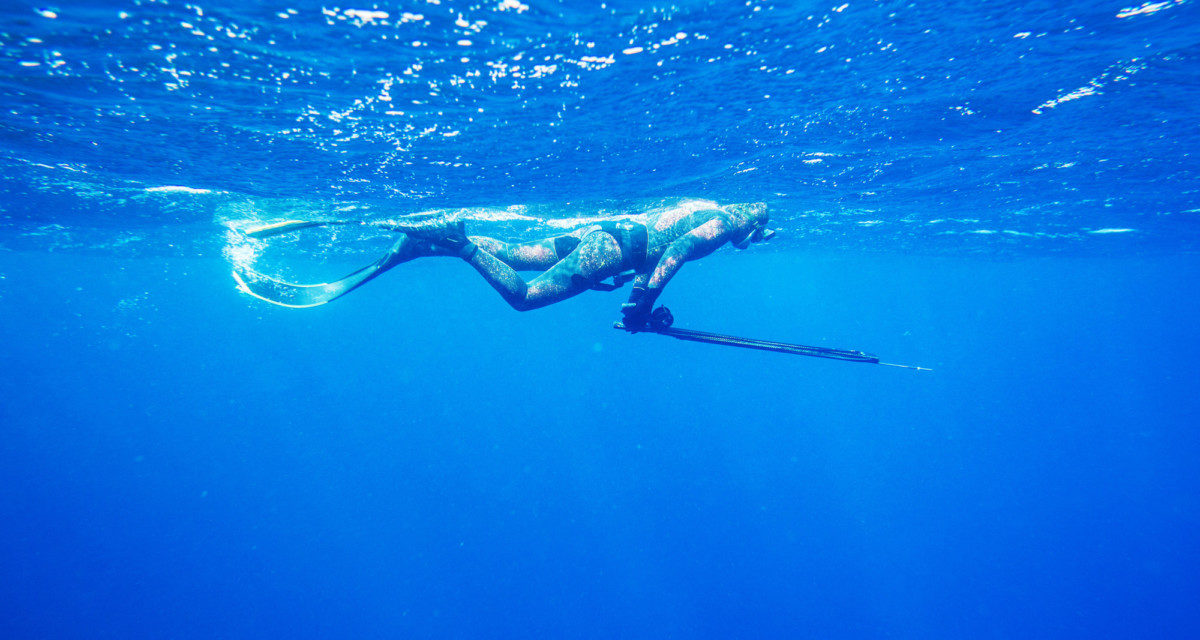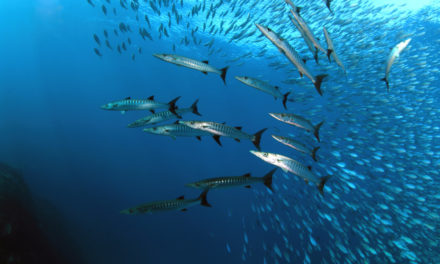Are you looking to go King Mackerel spearfishing? If so, read this guide to learn how to spearfish for King mackerel.
If you think that you’ve caught everything there is to catch as a spearo then you haven’t tried your hand at spearfishing King Mackerel yet. They’re fast and notoriously tough so it can be a fun challenge that will leave you with a sense of accomplishment for years to come when you do catch one. Not to mention that they taste delicious.
Feel like you’re up to the task? If so, you’re going to need to follow these spearfishing tips so you know where to look for them, when to go fishing and the technique that you’ll need to use to wrestle one in.
1. Conditions
Before you go King Mackerel spearfishing, you’ll have to know where to find them.
Migration Patterns
Let me give you an overview of their migrations patterns in the USA. There are at least two groups of King Mackeral off the coast of the USA. One group can be found in the summer in the Gulf of Mexico (Texas) and then from November to March off the east coast of Florida.
The other group can be found in the spring and fall off the coast of North Carolina. This group of King Mackeral can then be found in the months of May through August in the waters of southeast Florida. You will also find the King patrolling the waters of the Caribbean and South America. You can find them in abundance of the coast of Brazil.
Much of this migration is based on water temperature. They seem to like to be in water ranging from 69 – 74 F. You will find that they like to stick together. If you are able to spear one…great. Get ready to go down for another. There will most likely be another one waiting for you.
Pro Tip: Track the water temperature and you will find the King.
Click here to take look at Rutger University’s satellite imagery of sea surface temperature.
Location
King Mackerel are notorious predators so they’re going to go where the food goes. Usually, this is around reefs, shipwrecks and other shallow ends of water where schools of fish like to hang out. They will go after baitfish (menhaden) aggressively and the water will fizz with excitement…time for you to go spearfishing! Another favorite of the King is going after Atlantic Croakers. You will find schools of Croakers off the southeast coast migrating in the fall and winter.
You will also find larger Kings from 30 – 60 feet and deeper.
Tides and Time of Day
While you can pretty much catch a King Mackeral around any time of day, you’ll probably have the most luck in the morning and late afternoon before the tide comes in. This is because again, they’re predators. Smaller fish are most active around this time so the mackerel are going to be around so they can get a piece of the action.
2. Technique
Now that you know how and when to find these large predators, it’s time we talked about how to actually catch one when you spot it. Here are a few techniques you’ll want to keep in mind so your catch doesn’t break off and get away.
Hide Your Eyes
King Mackerel are a little shy. If you’re not careful you’ll spook it and it will speed off as far away from you as it can get. You’ll want to keep your head down and avoid making eye contact with the fish.
You can still see the fish if you look up at it through your mask. It’s all about using your peripheral vision. Also, don’t get too trigger happy.
The mackerel will probably swim in circles around you for a bit. If you act too quickly and try to spear it while it’s still curious about you, you’ll lose it. Always stay calm and don’t get overly excited (it is exciting though). Quick jerky movements will always scare any fish away. Nice and easy is the key.
Shot Placement
The biggest thing you need to consider with these fish is that they are very soft. This said, when they take off swimming if you don’t spear it in the right spot, they’ll tear off and escape. The absolute best place you can spear one of these guys is the head.
The bone is tough there so the fish will have more of a struggle with getting free. Also, 9 times out of 10 if you spear it in the head it will kill it or at least damage it so badly that it won’t be able to take off as fast.
Another great place to spear it is between the dorsal and anal fin. The muscle tissue is a lot tougher in this area so it’s not very likely that they’ll be able to pull the spear out when they start swimming.
Be Gentle
When the fish takes off they’re going to pull you hard. Your instincts are going to scream at you to pull back just as hard but if you do, you’re only going to pull the spear out.
You’ll want to swim along with the fish, keep up with it and maintain a gentle pull on it. The fish will tire itself out to the point where you can wrestle it back to the boat without too much of a fuss.
Don’t Be Afraid to Call in a Buddy
If you spear it and you know that your shot is going to stick then you can apply a little bit more pressure and continue as you normally would with letting it tire itself and wrestling it back to the boat.
If you’re not so sure that you stuck it in an optimal place though, you’re going to need a little extra firepower. Never be afraid to call in a buddy to come running with a second spear.
Wrestling Match
Just because the fish seems to be done fighting doesn’t mean it actually is. Most of the time, it’s only playing dead and still has a little bit of energy left in it. At this point, it’s time to get your hands dirty.
Use the spear to get a little leverage so you can get your other hand into the gills. This should allow you to wrestle it back to the boat. If you have to, you can tire it out further by wrapping your legs around it.
Are King Mackeral and Spanish Mackerel The Same (very important)?
King Mackeral and Spanish Mackeral are not the same fish. You will come across many who classify both fish as being the same. They can be caught in the same waters, so use this guide to catch Spanish Mackerel too. They are also great to eat!
I can understand the misconception. This confusion mostly happens when comparing a juvenile King and Spanish Mackeral. At a quick look, both are shaped similar with a forked tail and have bronze colored spots. The Spanish having more pronounced spots I find. But a major difference is the Spanish have a black spot on the first dorsal fin. The King will not and the first dorsal fin will be lighter in appearance. The Spanish, also have a slight curve of the lateral line just below the second dorsal fin to the tail. In contrast, the King’s lateral line is much more distinct to the tail. Also, you find the King will have more razor-like teeth compared to the Spanish.
Click here to take a look at a visual graphic showing the difference between the two fish.
It is common to spear 15 – 25 lbs King Mackeral, but they can be a lot larger. The world record line caught King is just below 100 lbs. So, they are out there.
A typical adult Spanish Mackeral is about 7 – 10 lbs.
The limit size of the two fish is very different. Always check the latest regulations when spearfishing, but at the time of writing this post these are regulations for North Carolina and Florida.
North Carolina:
King Mackeral –
24 inches long, fork length (from the tip of the snout to the fork in the tail)
3 fish per day (per person)
North Carolina Fishing Regulations
Spanish Mackeral –
- 12 inches long, fork length
- 15 fish per day (per person)
Florida:
King Mackeral –
- 24 inches long, fork length (from the tip of the snout to the fork in the tail)
- 2 fish per day (per person)
Florida Fish and Wildlife – King Mackeral Regulations
Spanish Mackeral –
- 12 inches long, fork length
- 15 fish per day (per person)
Take note of these regulations. Knowbody needs a $300 plus fine for not knowing the difference between the two fish. I would rather spend the money on a new speargun.
Your Guide to Spearfishing a King Mackerel
You haven’t met a challenge quite like spearfishing a King Mackerel. They’re huge and have a ton of power which makes it all the more fun. They taste amazing too.
Use these tips for spearfishing a King Mackerel to make the biggest catch of the day.
One secret to spearfishing is going in with the right gear. Keep reading for tips on how to pick out the best speargun for your adventure.






